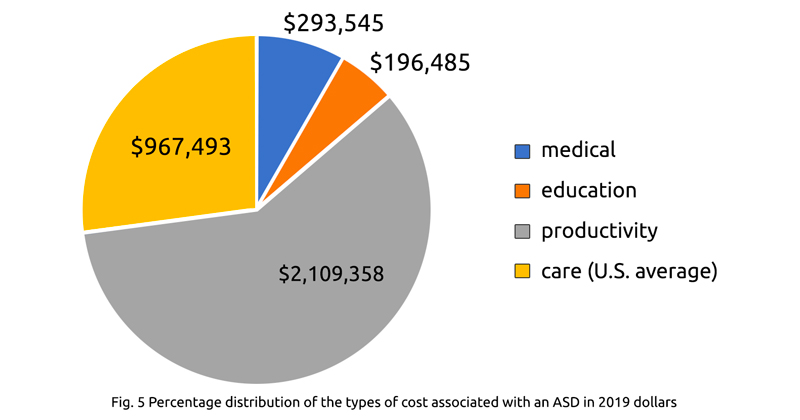Next Decade Will Add More Trillions to Looming Public Financial Burden
The lifetime cost of autism for U.S. cases identified in the 30 years between 1990 and 2019 is estimated to be $7 trillion. If costs for the next decade 2020-2029 are included, the lifetime cost will reach up to $15 trillion. The findings were reported in a new study in the journal Research in Autism Spectrum Disorders.
In “The Lifetime Social Cost of Autism: 1990–2029”, authors Janet Cakir, Richard Frye, and Stephen Walker compiled findings from peer-reviewed published studies on the number of cases of autism for the decades 1990-2019 and the lifetime cost of autism per person in the U.S.
For prevalence, they used the two best known Federal monitoring systems: the CDC’s Autism and Developmental Disabilities Monitoring Network (ADDM) and the National Health Interview Survey (NHIS) by the National Center for Health Statistics. They estimated that 2 million new cases of autism were identified between 1990 and 2019. They factored in the severity of autism, specifically the comorbidity of intellectual disability which increases lifetime costs, and the estimated number of years living with autism. The number of years with autism is determined by the age of diagnosis and the person’s lifespan, which for those on the spectrum is shortened relative to the typically developing population.
For costs, they included the “social costs” across the lifespan. The costs are those incurred beyond what typically developing people would incur. They consist of medical and healthcare-related spending, therapies, special education services, lost wages for the person with ASD as well as parents/caregivers, accommodations, and respite care. The costs only reflect what society pays, not the expenses families incur out of their own pockets. Nor do the calculations reflect what the actual needs are of the person with autism, which are often greater than the resources available.
The average lifetime cost of autism per person was calculated to be $3.6 million. Projecting this amount to the autism prevalence data, they estimated the national social costs for all cases identified 1990-2019 to be $7 trillion. The greatest cost over the lifespan is from lost employment, followed by adult care. Medical care and education expenses were the lowest components.

Future costs for the 10 year period 2020-2029 were also estimated. During this period, if the autism rate is assumed to plateau at the prevalence of the most recent decade (2010-2019), the number of new cases will be 1 million and the lifetime cost for these 1 million will be over $4 trillion, bringing the 40 year total to $11 trillion. If prevalence continues to rise at the same rate as the past 30 years (1990-2019), over 2 million new cases will be identified and the cost will be another $7 1/2 trillion, for a total of almost $15 trillion.
The study reported costs by each of the 50 states as well as the national total. States with more generous social benefits and higher populations have seen and will see the highest economic burdens.
The authors characterize the financial burden of autism as significant. They suggest investing in screening to lower the age of diagnosis and increasing access to early intensive behavior intervention to help reduce disability, resulting in lower costs as the person ages. Another way to reduce financial burden, they conclude, is to identify the modifiable risk factors for autism to find ways to lower prevalence.
Reference:
Janet Cakir, Richard E.Frye, Stephen J.Walker. The lifetime social cost of autism: 1990–2029. Research in Autism Spectrum Disorders. Volume 72, April 2020.


